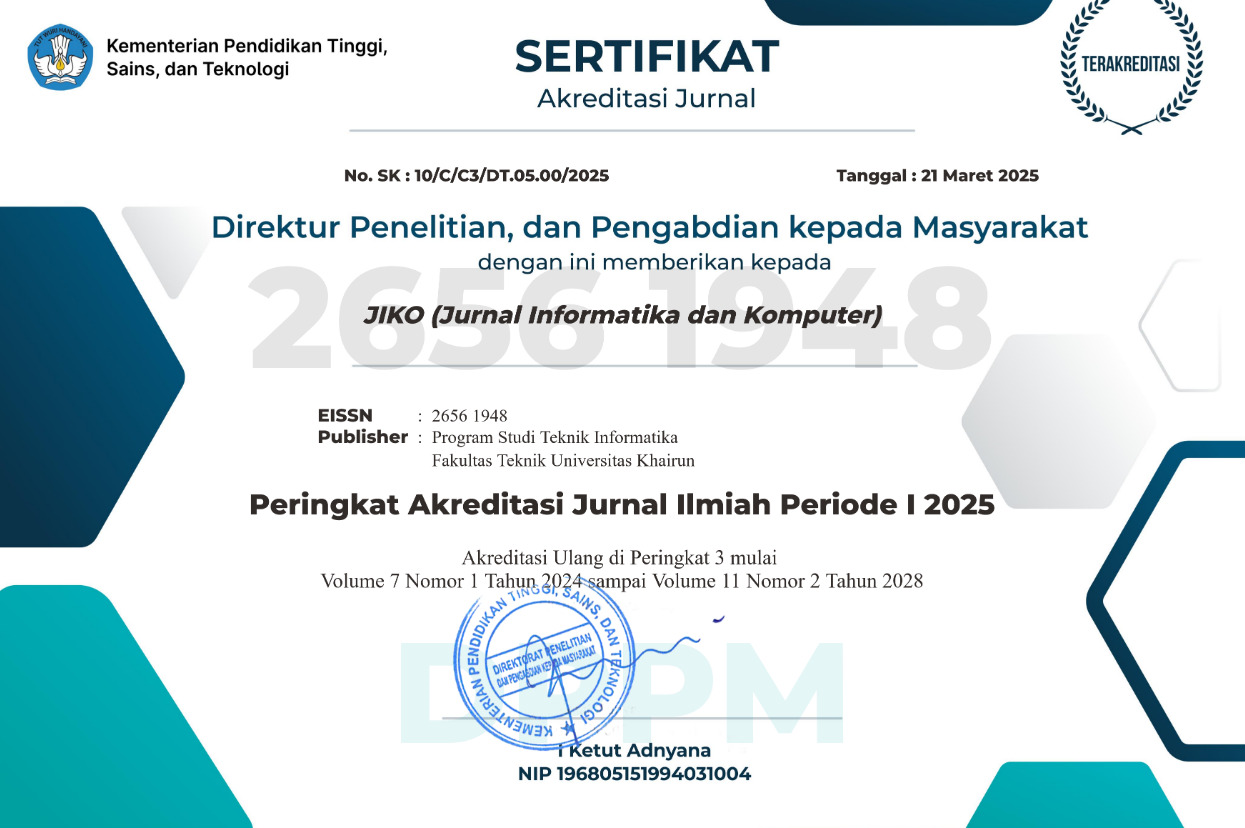OPTIMIZING HADITH CLASSIFICATION WITH NEURAL NETWORKS: A STUDY ON BUKHARI AND MUSLIM TEXTS
Abstract
The Bukhari and Muslim hadith collections encompass a total of 7008 hadith sentences, but it is not immediately clear which of these hadiths fall into the categories of prohibitions or orders. To enhance understanding and accessibility for readers, this study focuses on classifying these hadiths through a systematic process. The classification involves several key stages: Text Pre-processing, pre-processing the raw text data to clean and normalize (Stemming, Stopword Removal and Tokenization), Word vector features are extracted to capture the semantic relationships and contextual meanings of the words, then processed into a neural network model based on a multilayer perceptron (MLP) architecture (Model Architecture, Training and Optimization). The approach leverages the strength of neural networks, particularly through the use of multiple layers and feature extraction via word vectors, which significantly contributes to the accuracy of the classification process. The results of the study is very good, with a high accuracy rate of 97.72% achieved by employing a model with two layers and 256 neurons
Full Text:
PDFReferences
D. Sholehat and D. A. Alfiani, “Pengaruh Pola Asuh Permisif dari Orang Tua Terhadap Prestasi Belajar Siswa Pada Mata Pelajaran Al-Qur’an Hadits Kelas IV di Madrasah Ibtidaiyah,†Indones. J. Elem. Educ., vol. 1, no. 1, pp. 1–12, 2019.
A. Mufid, “Jamal Al-Banna’s Perspective on The Understanding Reconstruction of Changing Munkar: Decolonization of the Study of Islamic Thought From Textual to Contextual Knowledge,†J. Islam. Stud. Humanit., vol. 7, no. 1, pp. 84–95, 2022, doi: 10.18326/mlt.v7i1.7041.
H. M. Abdelaal, B. R. Elemary, and H. A. Youness, “Classification of Hadith According to Its Content Based on Supervised Learning Algorithms,†IEEE Access, vol. 7, pp. 152379–152387, 2019, doi: 10.1109/ACCESS.2019.2948159.
E. M. Dharma, F. Lumban Gaol, H. Leslie, H. S. Warnars, and B. Soewito, “THE ACCURACY COMPARISON AMONG WORD2VEC, GLOVE, AND FASTTEXT TOWARDS CONVOLUTION NEURAL NETWORK (CNN) TEXT CLASSIFICATION,†J. Theor. Appl. Inf. Technol., vol. 31, no. 2, 2022, Accessed: Aug. 30, 2024. [Online]. Available: www.jatit.org.
S. Park, J. Byun, S. Baek, Y. Cho, and A. Oh, “Subword-level word vector representations for Korean,†ACL 2018 - 56th Annu. Meet. Assoc. Comput. Linguist. Proc. Conf. (Long Pap., vol. 1, pp. 2429–2438, 2018, doi: 10.18653/v1/p18-1226.
Z. Li, F. Liu, W. Yang, S. Peng, and J. Zhou, “A Survey of Convolutional Neural Networks: Analysis, Applications, and Prospects,†IEEE Trans. Neural Networks Learn. Syst., vol. 33, no. 12, pp. 6999–7019, Dec. 2022, doi: 10.1109/TNNLS.2021.3084827.
T. Kim et al., “Spiking Neural Network (SNN) With Memristor Synapses Having Non-linear Weight Update,†Front. Comput. Neurosci., vol. 15, p. 646125, Mar. 2021, doi: 10.3389/FNCOM.2021.646125/BIBTEX.
M. W. Habibi, “Permainan edukatif puzzle surat Al-Qur’an (Q-Puzzle) menggunakan backpropagation sebagai penentu level permainan,†Jun. 2018.
I. Dwita, S. Tarigan, R. Habibi, R. Nuraini, and S. Fatonah, “Evaluasi Algoritma Klasifikasi Machine Learning Kategori Nilai Akhir Tunjangan Kinerja Pegawai,†J. Sist. Cerdas, vol. 6, no. 3, pp. 251–261, Dec. 2023, doi: 10.37396/JSC.V6I3.246.
M. Ghufran, A. Adiwijaya, and S. Al-Faraby, “Penerapan Particle Swarm Optimization Pada Feedforward Neural Network Untuk Klasifikasi Teks Hadis Bukhari Terjemahan Bahasa Indonesia,†J. Media Inform. Budidarma, vol. 2, no. 4, p. 165, 2018, doi: 10.30865/mib.v2i4.951.
A. Ramzy et al., “Hadiths Classification Using a Novel Author-Based Hadith Classification Dataset (ABCD),†Big Data Cogn. Comput. 2023, Vol. 7, Page 141, vol. 7, no. 3, p. 141, Aug. 2023, doi: 10.3390/BDCC7030141.
A. Y. Prathama et al., “Klasifikasi Anjuran , Larangan dan Informasi pada Hadis Sahih Al-Bukhari berdasarkan Model Unigram menggunakan Artificial Neural Network ( ANN ),†J. Teknosains, vol. 2, no. 3, pp. 1130–1139, 2018, [Online]. Available: http://j-ptiik.ub.ac.id/index.php/j-ptiik/article/view/2573%0Ahttp://eprints.undip.ac.id/35760/.
U. Nuha and N. Rochmawati, “Klasifikasi Kesahihan Hadits Berdasarkan Perawi Hadits Menggunakan Principal Component Analysis (PCA) dan Backpropagation Neural Network (BPNN),†J. Informatics Comput. Sci., vol. 1, no. 03, pp. 138–143, Jan. 2020, doi: 10.26740/JINACS.V1N03.P138-143.
A. A. Fadele, A. Kamsin, K. Ahmad, and H. Hamid, “A novel classification to categorise original hadith detection techniques,†Int. J. Inf. Technol., vol. 14, no. 5, pp. 2361–2375, Aug. 2022, doi: 10.1007/S41870-021-00649-3/FIGURES/4.
M. Y. Abu Bakar, Adiwijaya, and S. Al Faraby, “Multi-Label Topic Classification of Hadith of Bukhari (Indonesian Language Translation)Using Information Gain and Backpropagation Neural Network,†Proc. 2018 Int. Conf. Asian Lang. Process. IALP 2018, pp. 344–350, Jul. 2018, doi: 10.1109/IALP.2018.8629263.
S. Al Faraby, E. R. R. Jasin, A. Kusumaningrum, and Adiwijaya, “Classification of hadith into positive suggestion, negative suggestion, and information,†J. Phys. Conf. Ser., vol. 971, no. 1, p. 012046, Mar. 2018, doi: 10.1088/1742-6596/971/1/012046.
T. S. Gunawan et al., “Development of video-based emotion recognition using deep learning with Google Colab,†TELKOMNIKA (Telecommunication Comput. Electron. Control., vol. 18, no. 5, pp. 2463–2471, Oct. 2020, doi: 10.12928/TELKOMNIKA.V18I5.16717.
A. Khandare, N. Agarwal, A. Bodhankar, A. Kulkarni, and I. Mane, “Study of Python libraries for NLP,†Int. J. Data Anal. Tech. Strateg., vol. 15, no. 1–2, pp. 116–128, 2023, doi: 10.1504/IJDATS.2023.132564.
B. T. Chicho and A. B. Sallow, “A Comprehensive Survey of Deep Learning Models Based on Keras Framework,†J. Soft Comput. Data Min., vol. 2, no. 2, pp. 49–62, Oct. 2021, doi: 10.30880/jscdm.2021.02.02.005.
K. K. Chandriah and R. V. Naraganahalli, “RNN / LSTM with modified Adam optimizer in deep learning approach for automobile spare parts demand forecasting,†Multimed. Tools Appl., vol. 80, no. 17, pp. 26145–26159, Jul. 2021, doi: 10.1007/S11042-021-10913-0/FIGURES/5.
J. Xu, Y. Zhang, and D. Miao, “Three-way confusion matrix for classification: A measure driven view,†Inf. Sci. (Ny)., vol. 507, pp. 772–794, Jan. 2020, doi: 10.1016/J.INS.2019.06.064.
DOI: https://doi.org/10.33387/jiko.v7i2.8732
Refbacks
- There are currently no refbacks.











